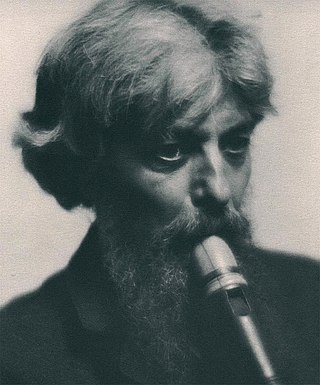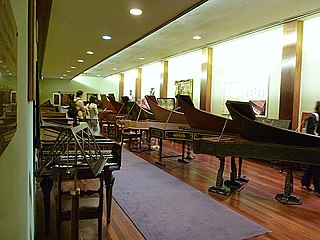
The clavichord is a stringed rectangular keyboard instrument that was used largely in the Late Middle Ages, through the Renaissance, Baroque and Classical eras. Historically, it was mostly used as a practice instrument and as an aid to composition, not being loud enough for larger performances. The clavichord produces sound by striking brass or iron strings with small metal blades called tangents. Vibrations are transmitted through the bridge(s) to the soundboard.

A harpsichord is a musical instrument played by means of a keyboard. Depressing a key raises its back end within the instrument, which in turn raises a mechanism with a small plectrum made from quill or plastic that plucks one or more strings. The strings are under tension on a soundboard, which is mounted in a wooden case; the soundboard amplifies the vibrations from the strings so that the listeners can hear it. Like a pipe organ, a harpsichord may have more than one keyboard manual, and even a pedal board. Harpsichords may also have stop levers which add or remove additional octaves. Some harpsichords may have a buff stop, which brings a strip of buff leather or other material in contact with the strings, muting their sound to simulate the sound of a plucked lute.

A keyboard instrument is a musical instrument played using a keyboard, a row of levers that are pressed by the fingers. The most common of these are the piano, organ, and various electronic keyboards, including synthesizers and digital pianos. Other keyboard instruments include celestas, which are struck idiophones operated by a keyboard, and carillons, which are usually housed in bell towers or belfries of churches or municipal buildings.
Ralph Leonard Kirkpatrick was an American harpsichordist and musicologist, widely known for his chronological catalog of Domenico Scarlatti's keyboard sonatas as well as for his performances and recordings.

Eugène Arnold Dolmetsch, was a French-born musician and instrument maker who spent much of his working life in England and established an instrument-making workshop in Haslemere, Surrey. He was a leading figure in the 20th-century revival of interest in early music.

Susi, Lady Jeans was an Austrian-born professional organist, teacher and musicologist.
Igor Kipnis was a German-born American harpsichordist, pianist and conductor.

Violet Gordon-Woodhouse was a British keyboard player. She specialised in the harpsichord and clavichord, and was influential in bringing both instruments back into fashion. She was the first person to record the harpsichord, and the first to broadcast harpsichord music.
Millicent Irene Silver was an English harpsichordist, who began her career as a pianist and violinist.
Robert Goble (1903–1991) was an English harpsichord builder.

The harpsichord was an important keyboard instrument in Europe from the 15th through the 18th centuries, and as revived in the 20th, is widely played today.

Valda Rose Aveling was an Australian pianist, harpsichordist and clavichordist. Her repertoire was very wide, including composers as diverse as William Byrd, Jan Sweelinck, Sergei Rachmaninoff and Béla Bartók.

Surendran Reddy was a South African composer and pianist.
Keith Richard Hill is a prize winning American maker of musical instruments He has conducted research into the acoustical technology employed by musical instrument makers from 1550–1850, and used this knowledge to create hundreds of harpsichords, clavichords and other instruments.

Alfred James Hipkins was an English musician, musicologist and musical antiquary.

Julian Perkins is a British conductor and keyboard player. Shortlisted for the Gramophone Award in 2021, he is Artistic Director of the Portland Baroque Orchestra in the US. He lives in London, England and is also Founder Director of the early music ensemble Sounds Baroque and Artistic Director of Cambridge Handel Opera Company.

The Russell Collection is a substantial collection of early keyboard instruments assembled by the British harpsichordist and organologist Raymond Russell. It forms part of the Musical Instrument Museums collection of the University of Edinburgh, and is housed in St Cecilia's Hall. Its full name is the Raymond Russell Collection of Early Keyboard Instruments.

Joan Rimmer was an English musicologist who specialised in the history of musical instruments and in historical dance forms. She was also a pioneer in ethnomusicology who presented, in the course of 30 years, numerous programmes on traditional music from around to the world on BBC radio.
Carl Frederick Dolmetsch (1911–1997) CBE was a French instrumentalist who specialised in the recorder.
Rudolph Arnold Dolmetsch was a harpsichordist, viol player, conductor and composer, a member of the famous Dolmetsch family of musicians. Dolmetsch died at the age of 36 in the sinking of the SS Ceramic in 1942. His concerto for clarinet, harp and orchestra (1939) was revived and recorded in 2019.













